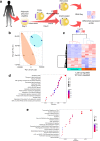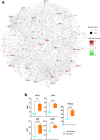Norepinephrine triggers an immediate-early regulatory network response in primary human white adipocytes
- PMID: 30390616
- PMCID: PMC6215669
- DOI: 10.1186/s12864-018-5173-0
Norepinephrine triggers an immediate-early regulatory network response in primary human white adipocytes
Abstract
Background: Norepinephrine (NE) signaling has a key role in white adipose tissue (WAT) functions, including lipolysis, free fatty acid liberation and, under certain conditions, conversion of white into brite (brown-in-white) adipocytes. However, acute effects of NE stimulation have not been described at the transcriptional network level.
Results: We used RNA-seq to uncover a broad transcriptional response. The inference of protein-protein and protein-DNA interaction networks allowed us to identify a set of immediate-early genes (IEGs) with high betweenness, validating our approach and suggesting a hierarchical control of transcriptional regulation. In addition, we identified a transcriptional regulatory network with IEGs as master regulators, including HSF1 and NFIL3 as novel NE-induced IEG candidates. Moreover, a functional enrichment analysis and gene clustering into functional modules suggest a crosstalk between metabolic, signaling, and immune responses.
Conclusions: Altogether, our network biology approach explores for the first time the immediate-early systems level response of human adipocytes to acute sympathetic activation, thereby providing a first network basis of early cell fate programs and crosstalks between metabolic and transcriptional networks required for proper WAT function.
Keywords: Early cell fate; Immediate-early gene; Network biology; Norepinephrine stimulation; Transcriptional regulatory network; White adipocyte.
Conflict of interest statement
Ethics approval and consent to participate
Donor samples and all experiments were performed in accordance with protocols approved by the Austrian Cluster for Tissue Regeneration, Linz, Austria. Samples were collected from each patient after obtaining their written informed consent. This study was performed according to the Declaration of Helsinki and approved by the local ethics commission (Ethikkommission des Landes Oberoesterreich). The analysis was conducted anonymously, without public disclosure of patient data.
Consent for publication
Not applicable.
Competing interests
The authors declare that they have no competing interests.
Publisher’s Note
Springer Nature remains neutral with regard to jurisdictional claims in published maps and institutional affiliations.
Figures




References
MeSH terms
Substances
Grants and funding
LinkOut - more resources
Full Text Sources

